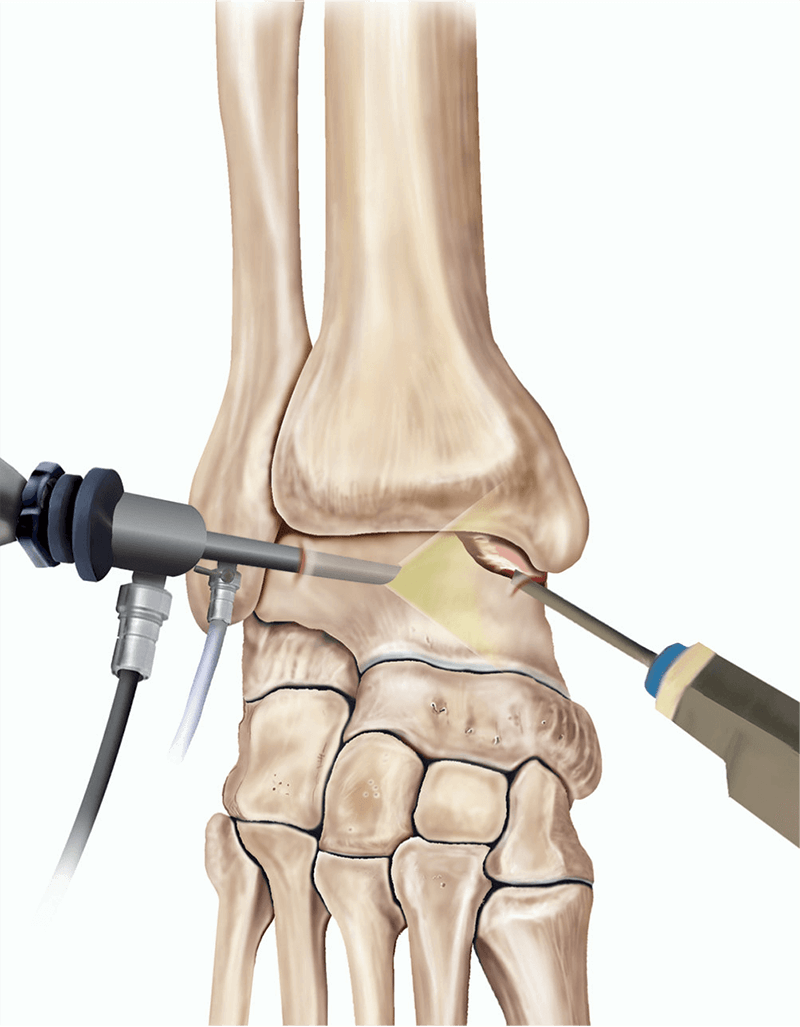FOOT & ANKLE
Ankle Arthroscopy
Ankle arthroscopy is a form of keyhole surgery that involves inserting a small telescope (arthroscope) into the ankle to help diagnose and/or treat common ankle injuries. The benefits of arthroscopy include small incisions, minimal scarring, fast healing and rapid recovery.
Ankle arthroscopy is minimally invasive surgery that has proved to be a highly effective way to address ankle disorders such:
- Excessive scarring os synovial proliferation in the ankle joint after injury - a common cause of ankle pain
- Debridement or removal of injured cartilage such as osteochondral lesions
- Loose bodies
- Shave intra-articular osteophytes (spurs)
- An adjunct to other procedures such as
- Ankle Ligament Reconstruction.
- Ankle Fusion Surgery (Arthrodesis).

Procedure
Arthroscopy is usually done through two to three small incisions around the ankle. A small telescope with a camera on the end projects the image onto a nearby monitor that allows the surgeon to get a closer look at the ankle joint. Here, Dr du Sart is looking for cartilage damage, inflamed synovial tissue (synovitis) or scarring, or bone spurs. If a diagnosis is made and treatment is required, Dr du Sart can insert tiny instruments through the other small incisions. After surgery, the instruments are removed and the incisions are stitched closed and covered with dressings and a bandage.
After You Operation
Pain Management
Post operation the foot is elevated to reduce swelling and local anaesthetic will provide pain relief and make the foot and toes temporarily numb. During your inpatient stay you will be given pain relief and either medication or prescriptions to go home to keep pain within comfort. Usually patients will initially require regular pain relief consisting of paracetamol and anti-inflammatories if indicated. Stronger medications may be given and helpful in early stages however are phased out as comfort levels increase.
Mobility
After surgery the ankle joint is immobilised with a splint or cast. The nature and duration of immobilisation will depend on the severity of injury and amount of repair performed. For the first two weeks you are recommended to keep the foot elevated as much as possible over the first two weeks to allow the wound to heal and minimise pain and swelling. Generally you can mobilise as tolerated post operatively however this is dependent on the extent of surgery. Physiotherapy may be required depending on the findings. Dr du Sart will give you specific guidance regarding your specific timeframes.
Return to Work and Sport
Return to work will vary on the nature of your work and what was done at surgery. In general, you should plan to have at least two weeks off work to allow your wound adequate time to heal and elevate your leg. You may be able to return to light duties after two weeks, but if you are on your feet at work, it may take 4 to 6 weeks. If you are very physically active in your job, it may take 6 to 9 weeks. Dr du Sart will discuss this with you at your post-op check.
Returning to sport such as jogging may take 6 to 9 weeks however this is dependent on the type and level of activity. Full recovery is expected in 3 months.
Driving
Times to return to driving will vary. If you have an automatic car and your left ankle was operated on, your return to driving may be faster. However, in general, plan to avoid driving for two weeks after surgery. Depending on the extent of your surgery and if your right ankle is operated on you may take longer to return to driving, however Dr du Sart will discuss this with you at your post operation review.

© All rights reserved
For all appointments and enquiries please contact us on:
Phone: 08 9779 9767
Email: admin@ryandusart.com.au
Address: 6 Higgins St, South Bunbury, 6230
